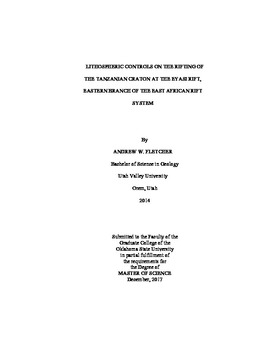| dc.contributor.advisor | Abdelsalam, Mohamed G. | |
| dc.contributor.author | Fletcher, Andrew | |
| dc.date.accessioned | 2018-06-25T16:31:17Z | |
| dc.date.available | 2018-06-25T16:31:17Z | |
| dc.date.issued | 2017-12-01 | |
| dc.identifier.uri | https://hdl.handle.net/11244/300293 | |
| dc.description.abstract | Continental rifts most often nucleate within the thinner and weaker lithosphere of orogenic belts at the margins of cratons, rather than within cratons themselves. However, some studies in the East African Rift System (EARS) have shown that continental rifts can develop crossing the boundaries of orogenic belts or even extend into cratons. This work provides insights into the processes leading to the rifting of cratons by investigating the Pleistocene age (~1.5 Ma) Eyasi Rift, which propagates in a WSW direction into the Archean-Paleoproterozoic age Tanzanian craton. The Eyasi Rift is located in the northern part of Tanzania where the Eastern Branch of the EARS transitions from a narrow rift (~70 km wide) to a wide rift referred to as the North Tanzanian Divergence (~300 km wide). However, unlike the rest of the Eastern Branch segments, the Eyasi Rift does not follow the Neoproterozoic age Mozambique orogenic belt located on the eastern margin of the Tanzanian craton. To better understand what lithospheric structures are contributing to the evolution of Eyasi Rift, this work generated lithospheric-scale cross-sections across the Eyasi Rift perpendicular to its longitudinal direction using: (1) Shuttle Radar Tomography Mission (SRTM) Digital Elevation Model (DEM) to map surface rift-related brittle structures; (2) Aeromagnetic data enhanced by a Source Parameter Imaging (SPI) filter to image the depth to the Precambrian crystalline basement; and (3) World Gravity Model 2012 (WGM 2012) to calculate crustal and lithospheric thickness by applying the two-dimensional (2D) radially-averaged power spectral analysis. These cross-sections show that the Eyasi Rift nucleates within a previously unidentified suture zone within the Tanzanian craton and that this suture zone is characterized by thinner lithosphere (as thin as ~95 km). This zone of thinner lithosphere is offset southeastward from the surface expression of the Eyasi Rift and this observation is used to advance a simple shear model for the rift evolution. Furthermore, the lithospheric thickness map indicates that the Tanzanian craton is heterogeneous and possibly composed of multiple smaller cratonic fragments. | |
| dc.format | application/pdf | |
| dc.language | en_US | |
| dc.rights | Copyright is held by the author who has granted the Oklahoma State University Library the non-exclusive right to share this material in its institutional repository. Contact Digital Library Services at lib-dls@okstate.edu or 405-744-9161 for the permission policy on the use, reproduction or distribution of this material. | |
| dc.title | Lithospheric Controls on the Rifting of the Tanzanian Craton at the Eyasi Rift, Eastern Branch of the East African Rift System | |
| dc.contributor.committeeMember | Atekwana, Estella | |
| dc.contributor.committeeMember | Lao Davila, Daniel A. | |
| osu.filename | Fletcher_okstate_0664M_15496.pdf | |
| osu.accesstype | Open Access | |
| dc.description.department | Geology | |
| dc.type.genre | Thesis | |
| dc.type.material | text | |
